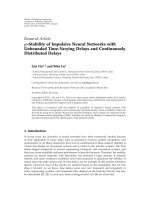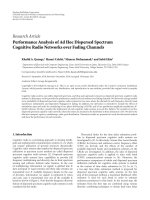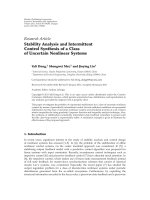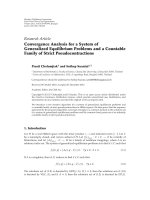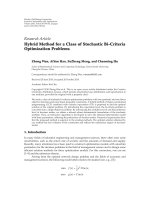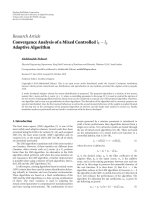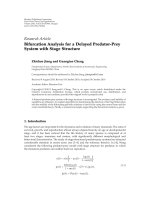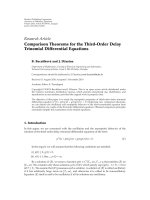Báo cáo hóa học: " Research Article Stability Analysis for Higher-Order Adjacent Derivative in Parametrized Vector Optimization" ppt
Bạn đang xem bản rút gọn của tài liệu. Xem và tải ngay bản đầy đủ của tài liệu tại đây (542.28 KB, 15 trang )
Hindawi Publishing Corporation
Journal of Inequalities and Applications
Volume 2010, Article ID 510838, 15 pages
doi:10.1155/2010/510838
Research Article
Stability Analysis for Higher-Order Adjacent
Derivative in Parametrized Vector Optimization
X. K. Sun and S. J. Li
College of Mathematics and Science, Chongqing University, Chongqing 400030, China
Correspondence should be addressed to X. K. Sun,
Received 29 March 2010; Accepted 3 August 2010
Academic Editor: Jong Kim
Copyright q 2010 X. K. Sun and S. J. Li. This is an open access article distributed under the
Creative Commons Attribution License, which permits unrestricted use, distribution, and
reproduction in any medium, provided the original work is properly cited.
By virtue of higher-order adjacent derivative of set-valued maps, relationships between higher-
order adjacent derivative of a set-valued map and its profile map are discussed. Some results
concerning stability analysis are obtained in parametrized vector optimization.
1. Introduction
Research on stability and sensitivity analysis is not only theoretically interesting but also
practically important in optimization theory. A number of useful results have been obtained
in scalar optimization see 1, 2. Usually, by stability, we mean the qualitative analysis,
which is the study of various continuity properties of the perturbation or marginal
function or map of a family of parametrized optimization problems. On the other hand,
by sensitivity, we mean the quantitative analysis, which is the study of derivatives of the
perturbation function.
Some authors have investigated the sensitivity of vector optimization problems. In 3,
Tanino studied some results concerning the behavior of the perturbation map by using the
concept of contingent derivative of set-valued maps for general multiobjective optimization
problems. In 4, Shi introduced a weaker notion of set-valued derivative TP-derivative and
investigated the behavior of contingent derivative for the set-valued perturbation maps in a
nonconvex vector optimization problem. Later on, Shi also established sensitivity analysis
for a convex vector optimization problem see 5.In6, Kuk et al. investigated the
relationships between the contingent derivatives of the perturbation maps i.e., perturbation
map, proper perturbation map, and weak perturbation map and those of feasible set map
in the objective space by virtue of contingent derivative, TP-derivative and Dini derivative.
Considering convex vector optimization problems, they also investigated the behavior of the
above three kinds of perturbation maps under some convexity assumptions see 7.
2 Journal of Inequalities and Applications
On the other hand, some interesting results have been proved for stability analysis in
vector optimization problems. In 8, Tanino studied some qualitative results concerning the
behavior of the perturbation map in convex vector optimization. In 9, Li investigated the
continuity and the closedness of contingent derivative of the marginal map in multiobjective
optimization. In 10, Xiang and Yin investigated some continuity properties of the mapping
which associates the set of efficient solutions to the objective function by virtue of the additive
weight method of vector optimization problems and the method of essential solutions.
To the best of our knowledge, there is no paper to deal with the stability of higher-order
adjacent derivative for weak perturbation maps in vector optimization problems. Motivated
by the work reported in 3–9, in this paper, by higher-order adjacent derivative of set-valued
maps, we first discuss some relationships between higher-order adjacent derivative of a set-
valued map and its profile map. Then, by virtue of the relationships, we investigate the
stability of higher-order adjacent derivative of the perturbation maps.
The rest of this paper is organized as follows. In Section 2, we recall some basic
definitions. In Section 3, after recalling the concept of higher-order adjacent derivative of set-
valued maps, we provide some relationships between the higher-order adjacent derivative
of a set-valued map and its profile map. In Section 4, we discuss some stability results of
higher-order adjacent derivative for perturbation maps in parametrized vector optimization.
2. Preliminaries
Throughout this paper, let X and Y be two finite dimensional spaces, and let K ⊆ Y be a
pointed closed convex cone with a nonempty interior int K, where K is said to be pointed
if K ∩ −K{0}.LetF : X ⇒ Y be a set-valued map. The domain and the graph of
F are defined by DomF{x ∈ X : Fx
/
∅} and GraphF{x, y ∈ X × Y : y ∈
Fx,x ∈ DomF}, respectively. The so-called profile map F K : X ⇒ Y is defined by
F Kx : FxK, for all x ∈ Dom
F.
At first, let us recall some important definitions.
Definition 2.1 see 11.LetQ be a nonempty subset of Y. An elements y ∈ Q is said to be
a minimal point resp. weakly minimal point of Q if Q − y ∩ −K{0}resp., Q − y ∩
− int K∅. The set of all minimal points resp., weakly minimal point of Q is denoted by
Min
K
Q resp., WMin
K
Q.
Definition 2.2 see 12.AbaseforK is a nonempty convex subset B of Kwith 0
/
∈ B such that
every k ∈ K, k
/
0 has a unique representation k αb, where b ∈ B and α>0.
Definition 2.3 see 13. The weak domination property is said to hold for a subset H of Y if
H ⊆ WMin
K
H int K ∪{0}.
Definition 2.4 see 14.LetF be a set-valued map from X to Y .
i F is said to be lower semicontinuous l.s.c at
x ∈ X if for any generalized sequence
{x
n
} with x
n
→ x and y ∈ Fx, there exists a generalized sequence {y
n
} with
y
n
∈ Fx
n
such that y
n
→ y.
ii F is said to be upper semicontinuous u.s.c at
x ∈ X if for any neighborhood
NF
x of Fx, there exists a neighborhood Nx of x such that Fx ⊆ NFx,
for all x ∈ N
x.
Journal of Inequalities and Applications 3
iii F is said to be closed at
x ∈ X if for any generalized sequence x
n
,y
n
∈ GraphF,
x
n
,y
n
→ x, y, it yields x, y ∈ GraphF.
We say that F is l.s.c resp., u.s.c, closed on X if it is l.s.c resp., u.s.c, closed at each x ∈ X.
F is said to be continuous on X if it is both l.s.c and u.s.c on X.
Definition 2.5 see 14. F is said to be Lipschitz around
x ∈ X if there exist a real number
M>0 and a neighborhood N
x of x such that
F
x
1
⊆ F
x
2
M
x
1
− x
2
B
Y
, ∀x
1
,x
2
∈ N
x
, 2.1
where B
Y
denotes the closed unit ball of the origin in Y .
Definition 2.6 see 14. F is said to be uniformly compact near
x ∈ X if there exists a
neighborhood N
x of x such that
x∈Nx
Fx is a compact set.
3. Higher-Order Adjacent Derivatives of Set-Valued Maps
In this section, we recall the concept of higher-order adjacent derivative of set-valued maps
and provide some basic properties which are necessary in the following section. Throughout
this paper, let m be an integer number and m>1.
Definition 3.1 see 15.Let
x ∈ C ⊆ X and u
1
, ,u
m−1
be elements of X.Theset
T
bm
C
x, u
1
, ,u
m−1
is called the mth-order adjacent set of C at x, u
1
, ,u
m−1
,ifandonly
if, for any x ∈ T
bm
C
x, u
1
, ,u
m−1
, for any sequence {h
n
}⊆R
\{0} with h
n
→ 0, there
exists a sequence {x
n
}⊆X with x
n
→ x such that
x h
n
u
1
h
2
n
u
2
··· h
m−1
n
u
m−1
h
m
n
x
n
∈ C, ∀n.
3.1
Definition 3.2 see 15.Let
x, y ∈ GraphF and u
i
,v
i
∈ X × Y , i 1, 2, ,m − 1.
The mth-order adjacent derivative D
bm
Fx, y,u
1
,v
1
, ,u
m−1
,v
m−1
of F at x, y for vectors
u
1
,v
1
, ,u
m−1
,v
m−1
is the set-valued map from X to Y defined by
Graph
D
bm
F
x, y,u
1
,v
1
, ,u
m−1
,v
m−1
T
bm
Graph
F
x, y,u
1
,v
1
, ,u
m−1
,v
m−1
. 3.2
Proposition 3.3. Let
x, y ∈ GraphF and u
i
,v
i
∈ X × Y, i 1, 2, ,m− 1. Then, for any
x ∈ DomD
bm
Fx, y,u
1
,v
1
, ,u
m−1
,v
m−1
,
D
bm
F
x, y,u
1
,v
1
, ,u
m−1
,v
m−1
x
K ⊆ D
bm
F K
x, y,u
1
,v
1
, ,u
m−1
,v
m−1
x
.
3.3
Proof. The proof follows on the lines of Proposition 2.1in3 by replacing contingent
derivative by mth-order adjacent derivative.
Note that the converse inclusion of 3.3 may not hold. The following example explains
the case where we only take m 2, 3.
4 Journal of Inequalities and Applications
Example 3.4. Let X Y R and K R
,letF : X ⇒ Y be defined by
F
x
⎧
⎨
⎩
{
0
}
if x ≤ 0,
−1,x
3
if x>0.
3.4
Let
x, y0, 0 ∈ GraphF and u
1
,v
1
u
2
,v
2
1, 0. For any x>0, we have
D
b2
F
x, y,u
1
,v
1
x
{
0
}
,D
b2
F K
x, y,u
1
,v
1
x
R,
D
b3
F
x, y,u
1
,v
1
,u
2
,v
2
x
{
1
}
,D
b3
F K
x, y,u
1
,v
1
,u
2
,v
2
x
R.
3.5
Thus, for any x>0, we have
D
b2
F K
x, y,u
1
,v
1
x
/
⊆ D
b2
F
x, y,u
1
,v
1
x
K,
D
b3
F K
x, y,u
1
,v
1
,u
2
,v
2
x
/
⊆ D
b3
F
x, y,u
1
,v
1
,u
2
,v
2
x
K.
3.6
Proposition 3.5. Let
x, y ∈ GraphF and u
i
,v
i
∈ X × Y , i 1, 2, ,m− 1. Assume that K
has a compact base. Then, for any x ∈ DomD
bm
Fx, y,u
1
,v
1
, ,u
m−1
,v
m−1
,
WMin
K
D
bm
F
K
x, y,u
1
,v
1
, ,u
m−1
,v
m−1
x
⊆ D
bm
F
x, y,u
1
,v
1
, ,u
m−1
,v
m−1
x
.
3.7
where
K is a closed convex cone contained in int K ∪{0}.
Proof. If WMin
K
D
bm
F
Kx, y, u
1
,v
1
, ,u
m−1
,v
m−1
x∅, the inclusion holds trivially.
Thus, we suppose that WMin
K
D
bm
F
Kx, y, u
1
,v
1
, ,u
m−1
,v
m−1
x
/
∅. Let y
0
∈
WMin
K
D
bm
F
Kx, y, u
1
,v
1
, ,u
m−1
,v
m−1
x. Then,
y
0
∈ D
bm
F
K
x, y,u
1
,v
1
, ,u
m−1
,v
m−1
x
. 3.8
Since
K ⊆ int K ∪{0},
WMin
K
D
bm
F
K
x, y,u
1
,v
1
, ,u
m−1
,v
m−1
x
⊆ Min
K
D
bm
F
K
x, y,u
1
,v
1
, ,u
m−1
,v
m−1
x
,
3.9
then it follows that
y
0
∈ Min
K
D
bm
F
K
x, y,u
1
,v
1
, ,u
m−1
,v
m−1
x
. 3.10
Journal of Inequalities and Applications 5
From 3.8 and the definition of mth-order adjacent derivative, we have that for any sequence
{h
n
}⊆R
\{0} with h
n
→ 0, there exist sequences {x
n
,y
n
} with x
n
,y
n
→ x, y
0
and
{
k
n
}⊆
K such that
y h
n
v
1
··· h
m−1
n
v
m−1
h
m
n
y
n
−
k
n
∈ F
x h
n
u
1
··· h
m−1
n
u
m−1
h
m
n
x
n
. 3.11
Since
K is a closed convex cone contained in int K ∪{0},
K has a compact base. It is clear
that B ∩
K is a compact base for
K, where B is a compact base for K. In this proposition, we
assume that
B is a compact base of
K. Since
k
n
∈
K, there exist α
n
> 0andb
n
∈
B such that
k
n
α
n
b
n
. Since
B is compact, we may assume without loss of generality that b
n
→ b ∈
B.
Now, we show that α
n
/h
m
n
→ 0. Suppose that α
n
/h
m
n
0. Then, for some ε>0, we
may assume, without loss of generality, that α
n
/h
m
n
≥ ε, for all n.Letk
n
εh
m
n
/α
n
k
n
∈
K.
Then, we have
k
n
− k
n
∈
K.
3.12
By 3.11 and 3.12,weobtainthat
y h
n
v
1
··· h
m−1
n
v
m−1
h
m
n
y
n
− k
n
∈ F
x h
n
u
1
··· h
m−1
n
u
m−1
h
m
n
x
n
K. 3.13
From 3.13 and
k
n
/h
m
n
ε/α
n
k
n
εb
n
→ εb
/
0, we have
y
0
− εb ∈ D
bm
F
K
x, y,u
1
,v
1
, ,u
m−1
,v
m−1
x
, 3.14
which contradicts 3.10. Therefore, α
n
/h
m
n
→ 0andy
n
−
k
n
/h
m
n
→ y
0
. Thus, it follows from
3.11 that y
0
∈ D
bm
Fx, y,u
1
,v
1
, ,u
m−1
,v
m−1
x, and the proof is complete.
Remark 3.6. The inclusion of
WMin
K
D
bm
F K
x, y,u
1
,v
1
, ,u
m−1
,v
m−1
x
⊆ D
bm
F
x, y,u
1
,v
1
, ,u
m−1
,v
m−1
x
3.15
may not hold under the assumptions of Proposition 3.5. The following example explains the
case where we only take m 2, 3.
Example 3.7. Let X R and Y R
2
,letK R
2
and F : X ⇒ Y be defined by
F
x
y ∈ R
2
: y
x
3
,x
3
. 3.16
6 Journal of Inequalities and Applications
Suppose that
x, y0, 0, 0 ∈ GraphF, u
1
,v
1
u
2
,v
2
1, 0, 0. Then, for any
x ∈ X,
D
b2
F
x, y,u
1
,v
1
x
{
0, 0
}
,
D
b3
F
x, y,u
1
,v
1
,u
2
,v
2
x
{
1, 1
}
,
D
b2
F K
x, y,u
1
,v
1
x
y
1
,y
2
∈ R
2
: y
1
≥ 0,y
2
≥ 0
,
D
b3
F K
x, y,u
1
,v
1
,u
2
,v
2
x
y
1
,y
2
∈ R
2
: y
1
≥ 1,y
2
≥ 1
.
3.17
Naturally, we have
WMin
K
D
b2
F K
x, y,u
1
,v
1
x
y
1
,y
2
∈ R
2
: y
1
y
2
0,y
1
≥ 0,y
2
≥ 0
,
WMin
K
D
b3
F K
x, y,u
1
,v
1
,u
2
,v
2
x
y
1
,y
2
∈ R
2
: y
1
≥ 1,y
2
1
∪
y
1
,y
2
∈ R
2
: y
1
1,y
2
≥ 1
.
3.18
Thus, for any x ∈ X,
WMin
K
D
b2
F K
x, y,u
1
,v
1
x
/
⊆ D
b2
F
x, y,u
1
,v
1
x
,
WMin
K
D
b3
F K
x, y,u
1
,v
1
,u
2
,v
2
x
/
⊆ D
b3
F
x, y,u
1
,v
1
,u
2
,v
2
x
.
3.19
Proposition 3.8. Let
x, y ∈ GraphF, and u
i
,v
i
∈ X × Y, i 1, 2, ,m − 1, and let K
has a compact base. Suppose that Px : D
bm
F
Kx, y, u
1
,v
1
, ,u
m−1
,v
m−1
x fulfills the
weak domination property for any x ∈ DomD
bm
Fx, y,u
1
,v
1
, ,u
m−1
,v
m−1
. Then, for any
x ∈ DomD
bm
Fx, y,u
1
,v
1
, ,u
m−1
,v
m−1
,
WMin
K
D
bm
F
K
x, y,u
1
,v
1
, ,u
m−1
,v
m−1
x
WMin
K
D
bm
F
x, y,u
1
,v
1
, ,u
m−1
,v
m−1
x
,
3.20
where
K is a closed convex cone contained in int K ∪{0}.
Proof. Let y
0
∈ WMin
K
D
bm
F
Kx, y, u
1
,v
1
, ,u
m−1
,v
m−1
x. Then,
y
0
∈ D
bm
F
K
x, y,u
1
,v
1
, ,u
m−1
,v
m−1
x
. 3.21
By Proposition 3.5, we also have y
0
∈ D
bm
Fx, y,u
1
,v
1
, ,u
m−1
,v
m−1
x.
Journal of Inequalities and Applications 7
Suppose that y
0
/
∈ WMin
K
D
bm
Fx, y,u
1
,v
1
, ,u
m−1
,v
m−1
x. Then, there exists y
∈
D
bm
Fx, y,u
1
,v
1
, ,u
m−1
,v
m−1
x such that
y
0
− y
∈ int K. 3.22
From y
∈ D
bm
Fx, y,u
1
,v
1
, ,u
m−1
,v
m−1
x and Proposition 3.3, we have
y
∈ D
bm
F
K
x, y,u
1
,v
1
, ,u
m−1
,v
m−1
x
. 3.23
So, by 3.21, 3.22,and3.23, y
0
/
∈ WMin
K
D
bm
F
Kx, y, u
1
,v
1
, ,u
m−1
,v
m−1
x, which
leads to a contradiction. Thus, y
0
∈ WMin
K
D
bm
Fx, y,u
1
,v
1
, ,u
m−1
,v
m−1
x.
Conversely, let y
0
∈ WMin
K
D
bm
Fx, y,u
1
,v
1
, ,u
m−1
,v
m−1
x. Then,
y
0
∈ D
bm
F
x, y,u
1
,v
1
, ,u
m−1
,v
m−1
x
⊆ D
bm
F
K
x, y,u
1
,v
1
, ,u
m−1
,v
m−1
x
.
3.24
Suppose that y
0
/
∈ WMin
K
D
bm
F
Kx, y, u
1
,v
1
, ,u
m−1
,v
m−1
x. Then, there exists y
∈
D
bm
F
Kx, y, u
1
,v
1
, ,u
m−1
,v
m−1
x such that
y
0
− y
k ∈ int K. 3.25
Since P x fulfills the weak domination property for any x ∈ DomD
bm
Fx, y,u
1
,v
1
, ,
u
m−1
,v
m−1
, there exists k
∈ int K ∪{0} such that
y
− k
∈ WMin
K
D
bm
F
K
x, y,u
1
,v
1
, ,u
m−1
,v
m−1
x
. 3.26
From 3.25 and 3.26, we have
y
0
− k − k
∈ WMin
K
D
bm
F
K
x, y,u
1
,v
1
, ,u
m−1
,v
m−1
x
. 3.27
It follows from Proposition 3.5 and 3.27 that
y
0
− k − k
∈ D
bm
F
x
,
y
,u
1
,v
1
, ,u
m−1
,v
m−1
x
,
3.28
which contradicts y
0
∈ WMin
K
D
bm
Fx, y,u
1
,v
1
, ,u
m−1
,v
m−1
x.Thus,y
0
∈
WMin
K
D
bm
F
Kx, y, u
1
,v
1
, ,u
m−1
,v
m−1
x, and the proof is complete.
Obviously, Example 3.4 can also show that the weak domination property of P x is
essential for Proposition 3.8.
8 Journal of Inequalities and Applications
Remark 3.9. From Example 3.7, the equality of
WMin
K
D
bm
F K
x, y,u
1
,v
1
, ,u
m−1
,v
m−1
x
WMin
K
D
bm
F
x, y,u
1
,v
1
, ,u
m−1
,v
m−1
x
3.29
may still not hold under the assumptions of Proposition 3.8.
Proposition 3.10. Let
x, y ∈ GraphF and u
i
,v
i
∈ X × Y, i 1, 2, ,m − 1.
Suppose that F is Lipschitz at
x. Then, D
bm
Fx, y,u
1
,v
1
, ,u
m−1
,v
m−1
is continuous on
DomD
bm
Fx, y,u
1
,v
1
, ,u
m−1
,v
m−1
.
Proof. Since F is Lipschitz at
x, there exist a real number M>0 and a neighborhood Nx of
x such that
F
x
1
⊆ F
x
2
M
x
1
− x
2
B
Y
, ∀x
1
,x
2
∈ N
x
. 3.30
First, we prove that D
bm
Fx, y,u
1
,v
1
, ,u
m−1
,v
m−1
is l.s.c. at x ∈ DomD
bm
Fx, y,
u
1
,v
1
, ,u
m−1
,v
m−1
. Indeed, for any y ∈ D
bm
Fx, y,u
1
,v
1
, ,u
m−1
,v
m−1
x.Fromthe
definition of mth-order adjacent derivative, we have that for any sequence {h
n
}⊆R
\{0}
with h
n
→ 0, there exists a sequence {x
n
, y
n
} with x
n
, y
n
→ x, y such that
y h
n
v
1
··· h
m−1
n
v
m−1
h
m
n
y
n
∈ F
x h
n
u
1
··· h
m−1
n
u
m−1
h
m
n
x
n
. 3.31
Take any x ∈ X and x
n
→ x. Obviously, x h
n
u
1
··· h
m−1
n
u
m−1
h
m
n
x
n
, x h
n
u
1
···
h
m−1
n
u
m−1
h
m
n
x
n
∈ Nx, for any n sufficiently large. Therefore, by 3.30, we have
F
x h
n
u
1
··· h
m−1
n
u
m−1
h
m
n
x
n
⊆ F
x h
n
u
1
··· h
m−1
n
u
m−1
h
m
n
x
n
Mh
m
n
x
n
− x
n
B
Y
.
3.32
So, with 3.31, there exists −b
n
∈ B
Y
such that
y h
n
v
1
··· h
m−1
n
v
m−1
h
m
n
y
n
M
x
n
− x
n
b
n
∈ F
x h
n
u
1
··· h
m−1
n
u
m−1
h
m
n
x
n
.
3.33
We may assume, without loss of generality, that b
n
→ b ∈ B
Y
.Thus,by3.33,
y M
x − x
b ∈ D
bm
F
x, y,u
1
,v
1
, ,u
m−1
,v
m−1
x
.
3.34
It follows from 3.34 that for any sequence {x
k
} with x
k
→ x, y ∈ D
bm
Fx, y,u
1
,v
1
, ,
u
m−1
,v
m−1
x, there exists a sequence {y
k
} with
y
k
: y M
x − x
k
b ∈ D
bm
F
x, y,u
1
,v
1
, ,u
m−1
,v
m−1
x
k
.
3.35
Journal of Inequalities and Applications 9
Obviously, y
k
→ y. Hence, D
bm
Fx, y,u
1
,v
1
, ,u
m−1
,v
m−1
is l.s.c. on DomD
bm
Fx, y,
u
1
,v
1
, ,u
m−1
,v
m−1
.
We will prove that D
bm
Fx, y,u
1
,v
1
, ,u
m−1
,v
m−1
is u.s.c. on x ∈ DomD
bm
Fx, y,
u
1
,v
1
, ,u
m−1
,v
m−1
. In fact, for any ε>0, we consider the neighborhood x ε/MB
X
of
x.Letx ∈ x ε/MB
X
and y ∈ D
bm
Fx, y,u
1
,v
1
, ,u
m−1
,v
m−1
x. From the definition
of D
bm
Fx, y,u
1
,v
1
, ,u
m−1
,v
m−1
x, we have that for any sequence {h
n
}⊆R
\{0} with
h
n
→ 0, there exists a sequence {x
n
,y
n
} with x
n
,y
n
→ x, y such that
y h
n
v
1
··· h
m−1
n
v
m−1
h
m
n
y
n
∈ F
x h
n
u
1
··· h
m−1
n
u
m−1
h
m
n
x
n
. 3.36
Take any x
n
→ x. Obviously, x h
n
u
1
···h
m−1
n
u
m−1
h
m
n
x
n
, xh
n
u
1
···h
m−1
n
u
m−1
h
m
n
x
n
∈
N
x, for any n sufficiently large. Therefore, by 3.30 , we have
F
x h
n
u
1
··· h
m−1
n
u
m−1
h
m
n
x
n
⊆ F
x h
n
u
1
··· h
m−1
n
u
m−1
h
m
n
x
n
Mh
m
n
x
n
− x
n
B
Y
.
3.37
Similar to the proof of l.s.c., there exists b ∈ B
Y
such that
y M
x − x
b ∈ D
bm
F
x, y,u
1
,v
1
, ,u
m−1
,v
m−1
x
.
3.38
Thus, y ∈ D
bm
Fx, y,u
1
,v
1
, ,u
m−1
,v
m−1
xεB
Y
. Hence,
D
bm
Fx, y,u
1
,v
1
, ,u
m−1
,v
m−1
is u.s.c. on DomD
bm
Fx, y,u
1
,v
1
, ,u
m−1
,v
m−1
,
and the proof is complete.
4. Continuity of Higher-Order Adjacent Derivative for
Weak Perturbation Map
In this section, we consider a family of parametrized vector optimization problems. Let F be a
set-valued map from U to Y , where U is the Banach space of perturbation parameter vectors,
Y is the objective space, and F is considered as the feasible set map in the objective space.
In the optimization problem corresponding to each parameter valued x, our aim is to find
the set of weakly minimal points of the feasible objective valued set Fx. Hence, we define
another set-valued map S from U to Y by
S
x
WMin
K
F
x
, for any x ∈ U. 4.1
The set-valued map S is called the weak perturbation map. Throughout this section, we
suppose that
K is a closed convex cone contained in int K ∪{0}.
Definition 4.1 see 11. F is said to be K-minicomplete by S near
x if Fx ⊆ SxK,for
any x ∈ N
x, where Nx is a neighborhood of x.
10 Journal of Inequalities and Applications
Remark 4.2. Since Sx ⊆ Fx,theK-minicompleteness of F by S near
x implies that
S
x
K F
x
K, for any x ∈ N
x
. 4.2
Hence, if F is K-minicomplete by S near
x, then, for any y ∈ Sx
D
bm
F K
x, y,u
1
,v
1
, ,u
m−1
,v
m−1
D
bm
S K
x, y,u
1
,v
1
, ,u
m−1
,v
m−1
.
4.3
The following lemma palys a crucial role in this paper.
Lemma 4.3. Let
x, y ∈ GraphS and u
i
,v
i
∈ U × Y , i 1, 2, ,m− 1, and let K have a
compact base. Suppose that the following conditions are satisfied:
i Px : D
bm
F
Kx, y, u
1
,v
1
, ,u
m−1
,v
m−1
x fulfills the weak domination
property for any x ∈ DomD
bm
Sx, y,u
1
,v
1
, ,u
m−1
,v
m−1
;
ii F is Lipschitz at
x;
iii F is
K-minicomplete by S near
x.
Then, for any x ∈ DomD
bm
Sx, y,u
1
,v
1
, ,u
m−1
,v
m−1
,
D
bm
S
x, y,u
1
,v
1
, ,u
m−1
,v
m−1
x
WMin
K
D
bm
F
x, y,u
1
,v
1
, ,u
m−1
,v
m−1
x
.
4.4
Proof. We first prove that
WMin
K
D
bm
F
x, y,u
1
,v
1
, ,u
m−1
,v
m−1
x
⊆ D
bm
S
x, y,u
1
,v
1
, ,u
m−1
,v
m−1
x
.
4.5
In fact, from Proposition 3.5, Proposition 3.8,andthe
K-minicompleteness of F by S near
x,
we have
WMin
K
D
bm
F
x, y,u
1
,v
1
, ,u
m−1
,v
m−1
x
WMin
K
D
bm
F
K
x, y,u
1
,v
1
, ,u
m−1
,v
m−1
x
WMin
K
D
bm
S
K
x, y,u
1
,v
1
, ,u
m−1
,v
m−1
x
⊆ D
bm
S
x, y,u
1
,v
1
, ,u
m−1
,v
m−1
x
.
4.6
Thus, result 4.5 holds.
Now, we prove that
D
bm
S
x, y,u
1
,v
1
, ,u
m−1
,v
m−1
x
⊆ WMin
K
D
bm
F
x, y,u
1
,v
1
, ,u
m−1
,v
m−1
x
.
4.7
Journal of Inequalities and Applications 11
In fact, assume that y ∈ D
bm
Sx, y,u
1
,v
1
, ,u
m−1
,v
m−1
x. Then, for any sequence {h
n
}⊆
R
\{0} with h
n
→ 0, there exists a sequence {x
n
,y
n
} with x
n
,y
n
→ x, y such that
y h
n
v
1
··· h
m−1
n
v
m−1
h
m
n
y
n
∈ S
x h
n
u
1
··· h
m−1
n
u
m−1
h
m
n
x
n
⊆ F
x h
n
u
1
··· h
m−1
n
u
m−1
h
m
n
x
n
.
4.8
Suppose that y
/
∈ WMin
K
D
bm
Fx, y,u
1
,v
1
, ,u
m−1
,v
m−1
x. Then, there exists y ∈
D
bm
Fx, y,u
1
,v
1
, ,u
m−1
,v
m−1
x such that y− y ∈ int K. Thus, for the preceding sequence
{h
n
}, there exists a sequence { x
n
, y
n
} with x
n
, y
n
→ x, y such that
y h
n
v
1
··· h
m−1
n
v
m−1
h
m
n
y
n
∈ F
x h
n
u
1
··· h
m−1
n
u
m−1
h
m
n
x
n
. 4.9
Obviously, x h
n
u
1
··· h
m−1
n
u
m−1
h
m
n
x
n
, x h
n
u
1
··· h
m−1
n
u
m−1
h
m
n
x
n
∈ Nx, for any
n sufficiently large. Therefore, by ii, we have
F
x h
n
u
1
··· h
m−1
n
u
m−1
h
m
n
x
n
⊆ F
x h
n
u
1
··· h
m−1
n
u
m−1
h
m
n
x
n
Mh
m
n
x
n
− x
n
B
Y
.
4.10
So, with 4.9, there exists −b
n
∈ B
Y
such that
y h
n
v
1
··· h
m−1
n
v
m−1
h
m
n
y
n
M
x
n
− x
n
b
n
∈ F
x h
n
u
1
··· h
m−1
n
u
m−1
h
m
n
x
n
.
4.11
Since y
n
− y
n
Mx
n
− x
n
b
n
→ y − y and y − y ∈ int K, y
n
− y
n
Mx
n
− x
n
b
n
∈ int K,
for n sufficiently large. Then, we have
y h
n
v
1
··· h
m−1
n
v
m−1
h
m
n
y
n
−
y h
n
v
1
···h
m−1
n
v
m−1
h
m
n
y
n
M
x
n
−x
n
b
n
∈ int K,
4.12
which contradicts 4.8. T hen, y ∈ WMin
K
D
bm
Fx, y,u
1
,v
1
, ,u
m−1
,v
m−1
x. This
completes the proof.
The following example shows that the
K-minicompleteness of F is essential in
Lemma 4.3, where we only take m 2, 3.
Example 4.4 F is not
K-minicomplete by S near
x.LetU R, Y R
2
and K R
2
,andlet
F : U ⇒ Y be defined by
F
x
y
1
,y
2
∈ R
2
: y
1
≥ 0,y
2
≥ 0
∪
y
1
,y
2
∈ R
2
: y
2
>
y
1
. 4.13
12 Journal of Inequalities and Applications
Then, for any x ∈ U,
F
x
K F
x
,S
x
y
1
,y
2
∈ R
2
: y
1
≥ 0,y
2
0
. 4.14
Suppose that
x, y0, 0, 0 ∈ GraphS, u
1
,v
1
u
2
,v
2
1, 0, 0. Then, F is
Lipschitz at
x, and for any x ∈ U,
D
b2
F
K
x, y,u
1
,v
1
x
D
b3
F
K
x, y,u
1
,v
1
,u
2
,v
2
x
y
1
,y
2
∈ R
2
: y
1
≥ 0,y
2
≥ 0
∪
y
1
,y
2
∈ R
2
: y
2
≥
y
1
4.15
fulfills the weak domination property. We also have
D
b2
F
x, y,u
1
,v
1
x
D
b3
F
x, y,u
1
,v
1
,u
2
,v
2
x
y
1
,y
2
∈ R
2
: y
1
≥ 0,y
2
≥ 0
∪
y
1
,y
2
∈ R
2
: y
2
≥
y
1
.
4.16
On the other hand,
D
b2
S
x, y,u
1
,v
1
x
D
b3
S
x, y,u
1
,v
1
,u
2
,v
2
x
S
x
,
WMin
K
D
b2
F
x, y,u
1
,v
1
x
WMin
K
D
b3
F
x, y,u
1
,v
1
,u
2
,v
2
x
y
1
,y
2
∈ R
2
: y
1
≥ 0,y
2
0
∪
y
1
,y
2
∈ R
2
: y
2
−y
1
,y
1
< 0
.
4.17
Thus, for any x ∈ X,
D
b2
S
x, y,u
1
,v
1
x
/
WMin
K
D
b2
F
x, y,u
1
,v
1
x
,
D
b3
S
x, y,u
1
,v
1
,u
2
,v
2
x
/
WMin
K
D
b3
F
x, y,u
1
,v
1
,u
2
,v
2
x
.
4.18
Theorem 4.5. Let
x, y ∈ GraphS and u
i
,v
i
∈ U × Y,i 1, 2, ,m − 1. Then,
D
bm
Sx, y,u
1
,v
1
, ,u
m−1
,v
m−1
x is closed on DomD
bm
Sx, y,u
1
,v
1
, ,u
m−1
,v
m−1
.
Proof. From the definition of D
bm
Sx, y,u
1
,v
1
, ,u
m−1
,v
m−1
x, we have that
Graph
D
bm
S
x, y,u
1
,v
1
, ,u
m−1
,v
m−1
T
bm
Graph
S
x, y,u
1
,v
1
, ,u
m−1
,v
m−1
. 4.19
Journal of Inequalities and Applications 13
Since T
bm
GraphS
x, y,u
1
,v
1
, ,u
m−1
,v
m−1
is closed set, D
bm
Sx, y,u
1
,v
1
, ,u
m−1
,v
m−1
is
closed on DomD
bm
Sx, y,u
1
,v
1
, ,u
m−1
,v
m−1
, and the proof is complete.
Theorem 4.6. Let x, y ∈ GraphS and u
i
,v
i
∈ U×Y, i 1, 2, ,m−1.IfY is a compact space,
then D
bm
Sx, y,u
1
,v
1
, ,u
m−1
,v
m−1
is u.s.c. on DomD
bm
Sx, y,u
1
,v
1
, ,u
m−1
,v
m−1
.
Proof. Since Y is a compact space, it follows from Corollary 9 of Chapter
3in14 and Theorem 4.5 that D
bm
Sx, y,u
1
,v
1
, ,u
m−1
,v
m−1
is u.s.c. on
DomD
bm
Sx, y,u
1
,v
1
, ,u
m−1
,v
m−1
. Thus, the proof is complete.
Theorem 4.7. Let x ∈ DomD
bm
Sx, y,u
1
,v
1
, ,u
m−1
,v
m−1
. Suppose t hat D
bm
Fx, y,
u
1
,v
1
, ,u
m−1
,v
m−1
x is a compact set and the assumptions of Lemma 4.3 are satisfied. Then,
D
bm
Sx, y,u
1
,v
1
, ,u
m−1
,v
m−1
is u.s.c. at x.
Proof. It follows from Lemma 4.3 and Theorem 4.5 that WMin
K
D
bm
Fx, y,
u
1
,v
1
, ,u
m−1
,v
m−1
is closed. By Proposition 3.10, we have that D
bm
Fx, y,u
1
,v
1
, ,
u
m−1
,v
m−1
is u.s.c. at x. Since D
bm
Fx, y,u
1
,v
1
, ,u
m−1
,v
m−1
x is a compact set, it
follows from Theorem 8 of Chapter 3 in 14 that
D
bm
S
x, y,u
1
,v
1
, ,u
m−1
,v
m−1
WMin
K
D
bm
F
x, y,u
1
,v
1
, ,u
m−1
,v
m−1
WMin
K
D
bm
F
x, y,u
1
,v
1
, ,u
m−1
,v
m−1
∩ D
bm
F
x, y,u
1
,v
1
, ,u
m−1
,v
m−1
4.20
is u.s.c. at x, and the proof is complete.
Now, we give an example to illustrate Theorem 4.7, where we also take m 2, 3.
Example 4.8. Let U 0, 1, Y R
2
,andK R
2
,andletF : U ⇒ Y be defined by
F
x
y
1
,y
2
∈ R
2
:0≤ y
1
≤ x
3
, 0 ≤ y
2
≤ x
3
. 4.21
Then, for any x ∈ U,
S
x
y
1
,y
2
∈ R
2
:0≤ y
1
≤ x
3
,y
2
0
∪
y
1
,y
2
∈ R
2
: y
1
0, 0 ≤ y
2
≤ x
3
. 4.22
Suppose that
x, y0, 0, 0 ∈ GraphS, x 1/3, u
1
,v
1
u
2
,v
2
1, 0, 0 and
K {y
1
,y
2
∈ R
2
: 1/4y
2
≤ y
1
≤ 4y
2
}. Obviously, K has a compact base, F is Lipschitz at
x, and F is
K-minicomplete by S near x. By direct calculating, for any x ∈ U,
D
b2
F
K
x, y,u
1
,v
1
x
K,
D
b3
F
K
x, y,u
1
,v
1
,u
2
,v
2
x
y
1
,y
2
∈ R
2
:0≤ y
1
≤ 4y
2
1, 0 ≤ y
2
≤ 4y
1
1
4.23
14 Journal of Inequalities and Applications
fulfill the weak domination property, which is a strong property for a set-valued map. We
also have
D
b2
F
x, y,u
1
,v
1
x
{
0, 0
}
,
D
b2
S
x, y,u
1
,v
1
x
{
0, 0
}
,
D
b3
F
x, y,u
1
,v
1
,u
2
,v
2
x
y
1
,y
2
∈ R
2
:0≤ y
1
≤ 1, 0 ≤ y
2
≤ 1
,
D
b3
S
x, y,u
1
,v
1
,u
2
,v
2
x
y
1
,y
2
∈ R
2
:0≤ y
1
≤ 1,y
2
0
∪
y
1
,y
2
∈ R
2
: y
1
0, 0 ≤ y
2
≤ 1
.
4.24
Thus, the conditions of Theorem 4.7 are satisfied. Obviously, both D
b2
Sx, y,u
1
,v
1
x and
D
b3
Sx, y,u
1
,v
1
,u
2
,v
2
x are u.s.c at x.
Theorem 4.9. Let x ∈ DomD
bm
Sx, y,u
1
,v
1
, ,u
m−1
,v
m−1
. Suppose t hat D
bm
Fx, y,
u
1
,v
1
, ,u
m−1
,v
m−1
is uniformly compact near x and the assumptions of Lemma 4.3 are satisfied.
Then, D
bm
Sx, y,u
1
,v
1
, ,u
m−1
,v
m−1
is l.s.c. at x.
Proof. By Lemma 4.3,itsuffices to prove that WMin
K
D
bm
Fx, y,u
1
,v
1
, ,u
m−1
,v
m−1
is l.s.c.
at x.Letx
n
→ x and
y ∈ WMin
K
D
bm
F
x, y,u
1
,v
1
, ,u
m−1
,v
m−1
x
.
4.25
By Proposition 3.10, we have that D
bm
Fx, y,u
1
,v
1
, ,u
m−1
,v
m−1
is l.s.c. at x. Then, there
exists a sequence {y
n
} with y
n
∈ D
bm
Fx, y,u
1
,v
1
, ,u
m−1
, v
m−1
x
n
such that y
n
→ y.
Since
K ⊆ int K ∪{0},
WMin
K
D
bm
F
x, y,u
1
,v
1
, ,u
m−1
,v
m−1
x
⊆ Min
K
D
bm
F
x, y,u
1
,v
1
, ,u
m−1
,v
m−1
x
.
4.26
Then, for any sequence {y
n
} with y
n
∈ WMin
K
D
bm
Fx, y,u
1
,v
1
, ,u
m−1
,v
m−1
x
n
,we
have
y
n
∈ Min
K
D
bm
F
x
,
y
,u
1
,v
1
, ,u
m−1
,v
m−1
x
n
,
4.27
then it follows that
y
n
− y
n
∈
K.
4.28
Since D
bm
Fx, y,u
1
,v
1
, ,u
m−1
,v
m−1
is uniformly compact near x, we may assume,
without loss of generality, that y
n
→ y. It follows from the closedness of D
bm
Fx, y,
u
1
,v
1
, ,u
m−1
,v
m−1
that
y ∈ D
bm
F
x, y,u
1
,v
1
, ,u
m−1
,v
m−1
x
. 4.29
Journal of Inequalities and Applications 15
From 4.28 and
K is closed, we have y − y ∈
K ⊆ int K ∪{0}. Then, it follows from 4.25 and
4.29 that y y.Thus,WMin
K
D
bm
Fx, y,u
1
,v
1
, ,u
m−1
,v
m−1
is l.s.c. at x, and the proof
is complete.
It is easy to see that Example 4.8 can also illustrate Theorem 4.9.
Acknowledgments
The authors would like to thank the anonymous referees for their valuable comments and
suggestions which helped to improve the paper. This research was partially supported by
the National Natural Science Foundation of China Grant no. 10871216 and Chongqing
University Postgraduates Science and Innovation Fund Grant no. 201005B1A0010338.
References
1 J. F. Bonnans and A. Shapiro, Perturbation Analysis of Optimization Problems, Springer Series in
Operations Research, Springer, New York, NY, USA, 2000.
2 A. V. Fiacco, Introduction to Sensitivity and Stability Analysis in Nonlinear Programming, vol. 165 of
Mathematics in Science and Engineering, Academic Press, Orlando, Fla, USA, 1983.
3 T. Tanino, “Sensitivity analysis in multiobjective optimization,” Journal of Optimization Theory and
Applications, vol. 56, no. 3, pp. 479–499, 1988.
4 D. S. Shi, “Contingent derivative of the perturbation map in multiobjective optimization,” Journal of
Optimization Theory and Applications, vol. 70, no. 2, pp. 385–396, 1991.
5 D. S. Shi, “Sensitivity analysis in convex vector optimization,” Journal of Optimization Theory and
Applications, vol. 77, no. 1, pp. 145–159, 1993.
6 H. Kuk, T. Tanino, and M. Tanaka, “Sensitivity analysis in vector optimization,” Journal of Optimization
Theory and Applications, vol. 89, no. 3, pp. 713–730, 1996.
7 H. Kuk, T. Tanino, and M. Tanaka, “Sensitivity analysis in parametrized convex vector optimization,”
Journal of Mathematical Analysis and Applications, vol. 202, no. 2, pp. 511–522, 1996.
8 T. Tanino, “Stability and sensitivity analysis in convex vector optimization,” SIAM Journal on Control
and Optimization, vol. 26, no. 3, pp. 521–536, 1988.
9 Shengjie Li, “Sensitivity and stability for contingent derivative in multiobjective optimization,”
Mathematica Applicata, vol. 11, no. 2, pp. 49–53, 1998.
10 S. W. Xiang and W. S. Yin, “Stability results for efficient solutions of vector optimization problems,”
Journal of Optimization Theory and Applications, vol. 134, no. 3, pp. 385–398, 2007.
11 Y. Sawaragi, H. Nakayama, and T. Tanino, Theory of Multiobjective Optimization, vol. 176 of Mathematics
in Science and Engineering, Academic Press, Orlando, Fla, USA, 1985.
12 R. B. Holmes, Geometric Functional Analysis and Its Applications, Springer, New York, NY, USA, 1975.
13 D.T. Luc, Theory of Vector Optimization, vol. 319 of Lecture Notes in Economics and Mathematical Systems,
Springer, Berlin, Germany, 1989.
14 J P. Aubin and I. Ekeland, Applied Nonlinear Analysis, Pure and Applied Mathematics, John Wiley &
Sons, New York, NY, USA, 1984.
15 J P. Aubin and H. Frankowska, Set-Valued Analysis, vol. 2 of Systems & Control: Foundations &
Applications,Birkh
¨
auser, Boston, Mass, USA, 1990.
